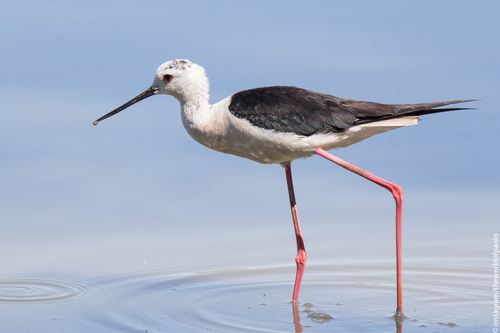
Black-winged Stilt
The Black-winged Stilt (*Himantopus himantopus*) is a strikingly elegant wader, renowned for its exceptionally long, pink legs and contrasting black-and-white plumage. It is a highly adaptable bird found across a wide range of wetland habitats globally. Ecologically, it plays a role in controlling invertebrate populations within these environments. While not holding particular cultural significance in many regions, its distinctive appearance and widespread distribution make it a familiar and easily recognizable species for birdwatchers.
33-40 cm
Length
67-83 cm
Wingspan
Least Concern
Conservation Status
Distribution
The Black-winged Stilt has an extensive distribution, spanning Europe, Africa, Asia, Australasia, and the Americas. Migratory patterns vary; some populations are resident, while others undertake long-distance migrations between breeding and wintering grounds. They are found from sea level to high-altitude wetlands.
Lifespan
Up to 12 years in the wild, although average lifespan is likely shorter.
Black-winged Stilt's Habitat
Habitat Types
Shallow freshwater wetlands, Brackish lagoons, Salt marshes, Estuaries, Flooded agricultural fields, Lake edges
Climate Zones
Tropical, Subtropical, Temperate, Mediterranean
Adaptations
Their exceptionally long legs allow them to wade in deeper water than many other shorebirds, accessing a wider range of prey. Their slender bill is adapted for probing in soft mud and picking small invertebrates from the water's surface.
Variations
Several subspecies have been proposed, based on subtle differences in plumage and size, but taxonomic clarity is still debated. Some regional variations exist, particularly in the extent of black on the head and neck.
Appearance
Breeding Plumage
Breeding plumage is generally more vibrant, with a sharper contrast between black and white. Non-breeding plumage may be slightly duller, with some greyish tones.
Seasonal Feather Changes
Some populations show seasonal variation in the extent of black on the head and neck, often more extensive during the breeding season.
Sex Based Plumage Differences
Males typically have a glossier black back, while females may have a brownish tinge to the black areas.
Notable Features
Exceptionally long, bright pink legs, Long, slender, straight black bill, White body with black wings and back, Black markings on the head (variable extent)
Diet and Feeding
Primary Foods
Aquatic invertebrates, Insects, Crustaceans, Mollusks, Small fish, Tadpoles, Occasionally seeds
Foraging Behavior
Black-winged Stilts typically wade in shallow water, probing the mud or picking prey from the surface. They may also swim in deeper water and upend to feed. They are often seen foraging in small groups.
Specializations
Their long legs and slender bill are key specializations for foraging in shallow wetlands. Their visual acuity is also well-developed for spotting prey.
Seasonal Diet Variations
Diet can vary seasonally depending on prey availability. During breeding season, they may consume more insects, while in winter, they may rely more on crustaceans and mollusks.
Behavior
Social Structure
Black-winged Stilts are often found in loose flocks, particularly outside the breeding season. During breeding, they may form small colonies or nest solitarily.
Communication
Sharp, repeated 'kik-kik-kik' calls, Alarm calls, Contact calls between parents and chicks, Visual displays, such as bowing and wing-flicking
Migration
Some populations are migratory, undertaking long-distance movements between breeding and wintering grounds. Others are resident or only make short-distance movements in response to water availability.
Territorial or Group Behaviors
During breeding, they defend a small territory around the nest. Outside the breeding season, they are generally non-territorial and may form large flocks at feeding and roosting sites.
Conservation
Threats
Habitat loss and degradation due to wetland drainage and conversion, Pollution of wetlands, Human disturbance, Climate change (affecting water availability), Predation by introduced species in some areas
Protection Programs
Wetland conservation and restoration projects, International agreements on migratory bird conservation (e.g., AEWA), Designation of protected areas (e.g., Ramsar sites)
Local National Laws
Protected under various national and international wildlife laws, including the Migratory Bird Treaty Act in the United States and the Birds Directive in the European Union.
Population Trend
Stable
Population Estimates
Global population estimated to be between 450,000 and 780,000 individuals.
Interesting Facts
They have the longest legs relative to their body size of any bird, except for flamingos.
This adaptation allows them to wade in deeper water than other shorebirds.
They are known to perform 'mobbing' behavior towards predators.
Groups of stilts will harass potential predators, such as birds of prey, to drive them away from nests or chicks.
The genus name *Himantopus* comes from the Greek words meaning 'strap foot'.
This refers to their long, slender legs.
Faqs about Black-winged Stilt
Are Black-winged Stilts aggressive?
They can be aggressive in defense of their nests and chicks, but are generally not aggressive towards humans unless they feel threatened.
What is the difference between a Black-winged Stilt and an Avocet?
While both are in the Recurvirostridae family, Avocets have upturned bills, whereas Stilts have straight bills. Avocets also tend to have more patterned plumage.
Where can I see Black-winged Stilts?
Look for them in shallow wetlands, marshes, and along the edges of lakes and lagoons in their wide geographic range.
Copyright @ Nature Style Limited. All Rights Reserved.
 English
English